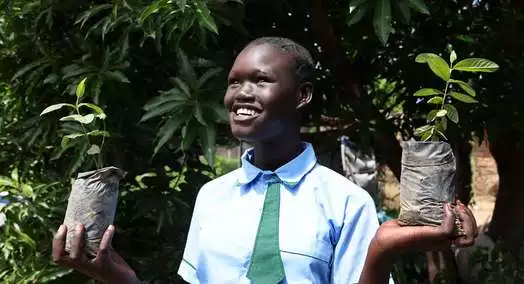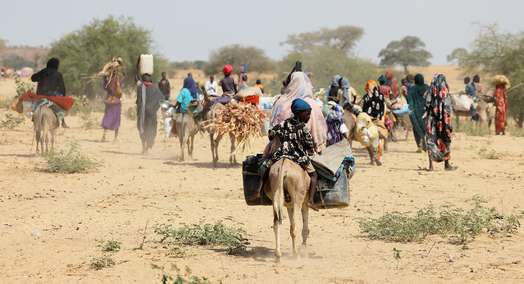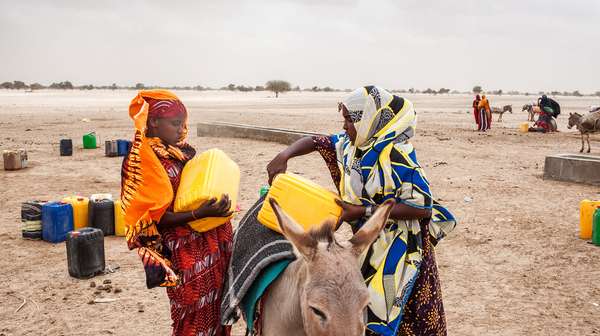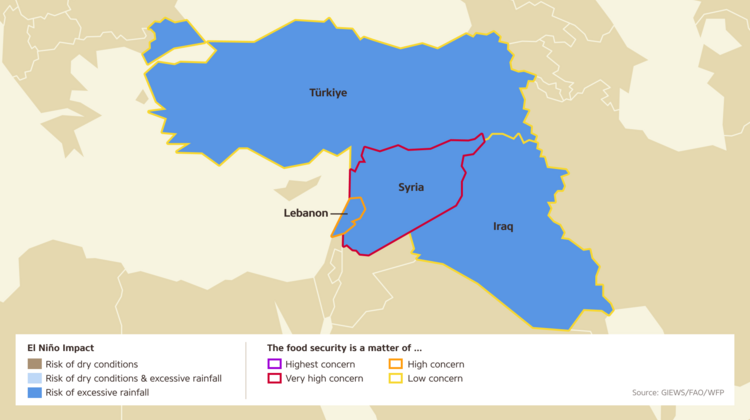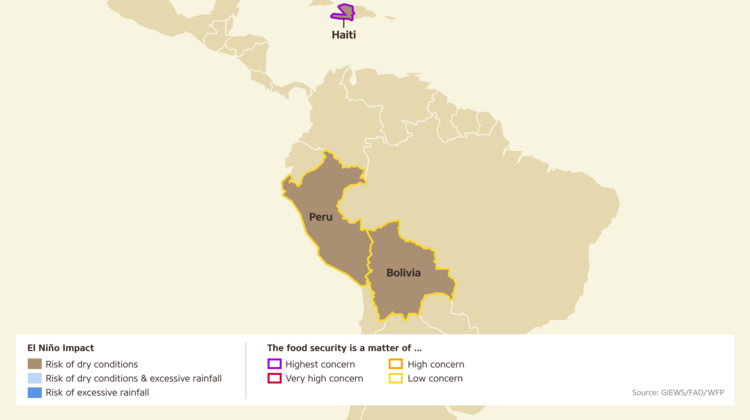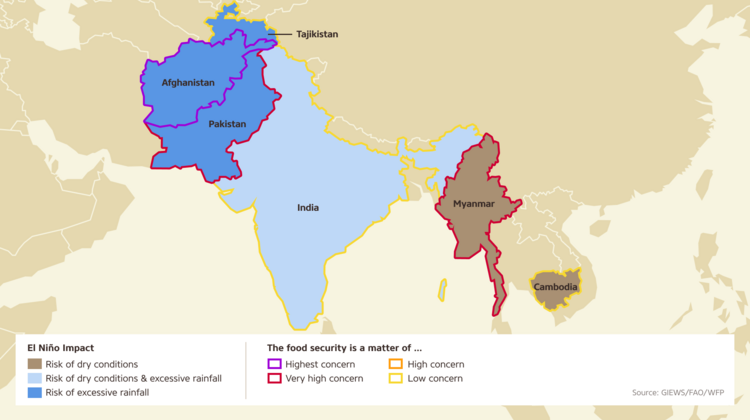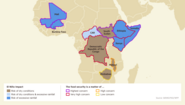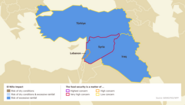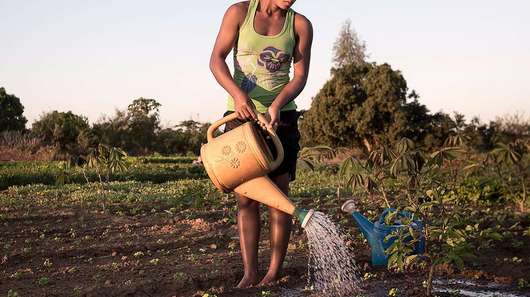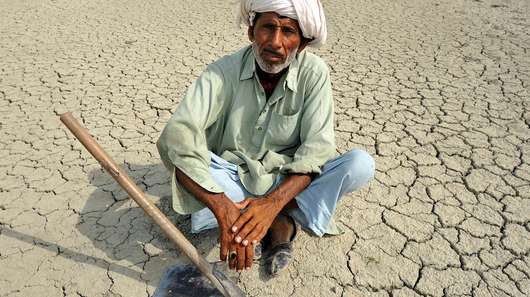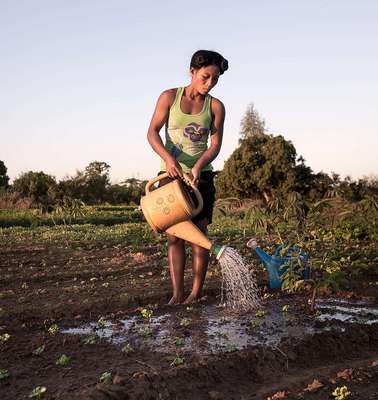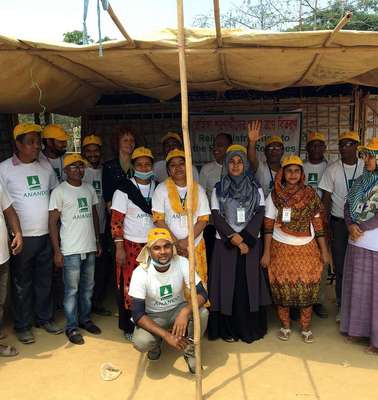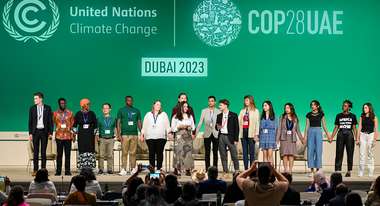Millions of people are starving and struggling to survive. Help now with a donation!
El Niño – The Origin & Impact of the Climate Pattern
Every few years, the weather phenomenon El Niño triggers extreme weather events in many regions of the world that lead to crop failures and hunger crises – or exacerbate existing crises. What is El Niño, what causes it and what are its effects?

The periodic weather phenomenon El Niño regularly triggers extreme weather events such as droughts and heavy rainfall in many regions of the world, which harms the food security of millions of people. At the beginning of July 2023, scientists once again predicted the onset of El Niño, meaning more disasters could also occur this year.
El Niño’s origins
Centuries ago, fishermen in Peru noticed a strange phenomenon every few years: the waters of the Pacific Ocean became unusually warm and schools of fish disappeared. Since this usually happened during the Christmas season, the phenomenon was at some point referred to by the Spanish word for "the boy" or "the Christ child": "El Niño". Scientists have linked ocean warming to unusual weather phenomena in other world regions, thus identifying a causal relationship that affects weather worldwide.
The El Niño phenomenon begins in the marine regions of the eastern Pacific. Here, the Humboldt Current typically brings cold water from the Antarctic region off the coast of South America. As the trade winds blowing from the southeast keep pushing the surface water warming at the ocean surface in the equator region westward toward Southeast Asia, new cold water keeps rising from the depths – the ocean temperature is permanently cool.
Is El Niño related to climate change?
El Niño is not a consequence of man-made climate change. It is a natural climate phenomenon that has been documented for centuries. However, global warming can intensify the effects of El Niño – periods of drought and dryness, as well as heatwaves, can become even more extreme.
At irregular intervals, however, the winds weaken for uncertain reasons so that the warmed surface water is no longer pushed westward – on the contrary, warmer water even sloshes back eastward, as it were. As a result, the cold deep water off South America is blocked from reaching the surface, and the upper ocean layers become persistently warm. Plankton dies in the warm water, so the shoals of fish off South America migrate.
Effects of the phenomenon on global weather
But that's not all. In turn, the changes in the upper ocean layers impact our Earth's atmosphere: Normally, the West Pacific in tropical latitudes is warmer than the East Pacific, which the Humboldt Current cools. Therefore, the air over the West Pacific warms more strongly and rises faster. This causes the air pressure to drop in the lower layers of the atmosphere, forming a low-pressure area into which air from the eastern Pacific flows – the result: an easterly wind.
In times of El Niño, on the other hand, the eastern Pacific is much warmer than usual, and the conditions reverse in extreme cases. The air in the east warms up, rises, and air flows in from the west, resulting in westerly winds over the Pacific.

This has severe consequences for the neighboring continents. With the westerly winds, warm air that has absorbed a lot of moisture over the sea reaches the American continent. Along the Andes, the moisture rains down, sometimes in extreme precipitation. In Australia and Southeast Asia, on the other hand, hardly any moist air arrives due to the wind reversal – the region suffers from drought and dryness, which in Australia is often accompanied by large fires.
The El Niño weather phenomenon does not only affect the Pacific region. The Earth's climate regions are interconnected in a highly complex web of causes and effects. With a greater or lesser delay, El Niño, therefore, also has consequences for climatic conditions in distant areas such as East Africa or the Sahel region.
Possible El Niño effects:
- Heavy rainfall in western South America
- Drought and dryness in Australia and Southeast Asia
- Dryness and drought in the Sahel region
- Heavy rainfall in East Africa
- Drought in southern Africa
- Drought in the Indian subcontinent
- Heavy rains in Central Asia
- Heavy rains in East Asia
- Heavy rainfall in southern North America
- Drought in northern South America and Central America
- Higher average temperatures in many regions
The weather phenomena do not all occur simultaneously, but at different times during an El Niño event.
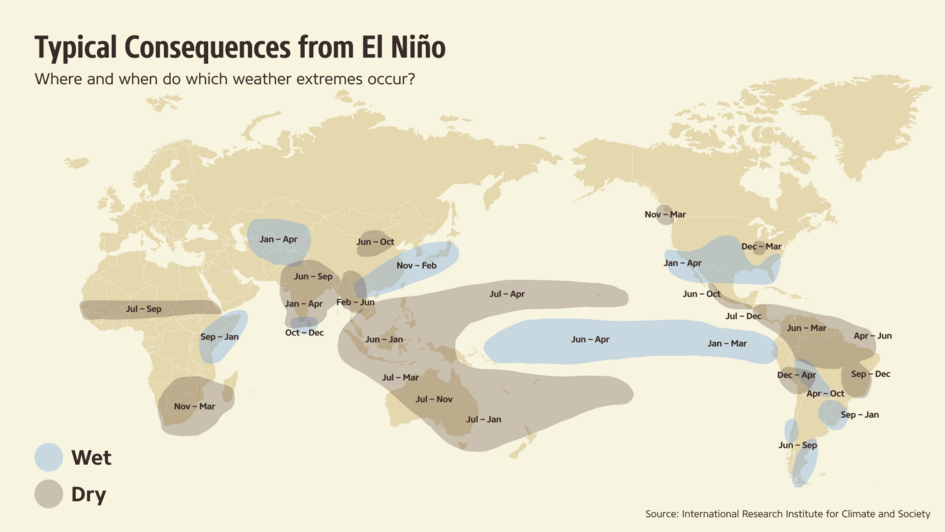
Consequences for people in affected regions
For people in severely affected areas such as southern and eastern Africa, the Sahel region or the countries of Southeast Asia, the abrupt climate changes pose a significant challenge. But not only for them: When drought or heavy rainfall lead to crop failures, food prices rise on the world market – with severe consequences even for regions not directly affected by the weather phenomena.
The last El Niño event of 2015/2016 severely affected more than 60 million people worldwide with droughts and heavy rainfall. Several African countries declared a national state of emergency. In southern Africa, food for more than 40 million people was at risk. Ethiopia experienced its worst drought in 50 years – 10 million people were dependent on food aid. In Haiti, drought cut crop yields in half. Not only did food supply become a problem, but persistent moisture also led to unusually high incidences of diseases, such as cholera and dengue fever, in various regions.
The 2023 El Niño hits a world already experiencing numerous crises. In many countries, the effects of the climate crisis are already dramatic. Weather extremes and disasters are increasing and destroying the livelihoods of millions of people, causing hunger and, in some cases, migration. Rural regions are particularly hard hit. El Niño could mean new extreme events. For example, East Africa is suffering from the worst drought in decades. El Niño will likely bring heavy rainfall to the region, which the arid soil will struggle to absorb – heavy flooding is on the horizon.
Food insecurity due to El Niño in different regions of the world
How is WHH helping?
The current El Niño phenomenon is a catastrophe in the making. Since experts predicted a new El Niño phase at the beginning of July 2023, the consequences of which will unfold over the next few months until at least February 2024, we have been preparing to stand by people in severely affected countries. We are monitoring forecasts for the countries where we are on the ground and putting contingency plans in place.
Many things can be done before a disaster occurs. Under the heading "Anticipatory Humanitarian Action," we are active with our partners in the run-up to a disaster to cushion the consequences of an anticipated disaster event.
Act and intervene based on forecasts and predictions before crises and disasters lead to hunger, destruction and death.
For example, in areas threatened by drought, we can distribute drought-tolerant seeds and ensure the functionality of wells and irrigation systems. Where flooding is feared, dams and dikes should be secured or evacuations prepared.
We can offer the people at risk tools and other materials they need to prepare for an emergency on their own, or we can provide money so the people affected can provide themselves with what they need.
We can assist farmers in vaccinating livestock as a preventive measure if there are likely food and water shortages. In individual cases, it may also make sense to sell the animals before such shortages or even to carry out emergency slaughter.
WHH attaches particular importance to cooperative work with local communities – only when people are involved in planning Anticipatory Humanitarian Action can measures meet their needs. Only if they know what they are facing and what they can do can they prevent and protect themselves.

